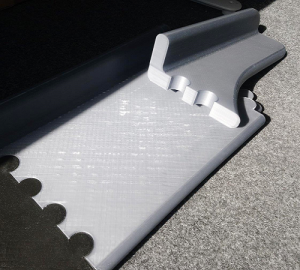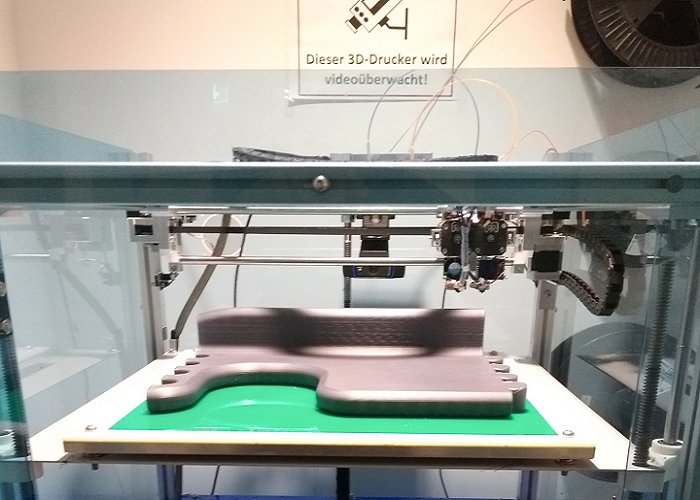 In order to validate the design of an important new component, while also saving on development costs, Airbus Helicopters is yet again turning to industrial 3D printer manufacturer German RepRap for 3D printing assistance, continuing their long partnership. The part is actually a helicopter step, made on the x400 3D printer that was purchased by Airbus Helicopters back in 2015.
In order to validate the design of an important new component, while also saving on development costs, Airbus Helicopters is yet again turning to industrial 3D printer manufacturer German RepRap for 3D printing assistance, continuing their long partnership. The part is actually a helicopter step, made on the x400 3D printer that was purchased by Airbus Helicopters back in 2015.
“The x400 is in use every day and often runs on weekends. The use of the readily available prototypes or demonstrators has become firmly established in our development process. The topic of 3D printing will definitely be expanded. We see this clearly in the future, especially in the development area,” the company said in a press release. “The use of the 3D printer makes it easier for the company to work, especially in the area of prototype construction and in automated production. You can see that clearly in the numbers. In 2017, almost 50 print jobs were carried out, often including several parts. In the first half of 2018 we already have 51 print jobs.”
 Airbus Helicopters purchased the x400 to more quickly and easily build and test its prototypes, as well as complete important FIT Checks. All of its designed parts start their lives off as 3D printed prototypes first, which the company then uses to check the instability and fitting for its helicopters. This way, it’s easy to transfer any potential adjustments and changes from the prototypes directly to the series parts.
Airbus Helicopters purchased the x400 to more quickly and easily build and test its prototypes, as well as complete important FIT Checks. All of its designed parts start their lives off as 3D printed prototypes first, which the company then uses to check the instability and fitting for its helicopters. This way, it’s easy to transfer any potential adjustments and changes from the prototypes directly to the series parts.
3D printing in the aerospace industry also helps companies, such as Airbus, meet their development deadlines and quality and cost goals, as well as make important new components.
“It happens again and again that a crew member of a helicopter stands outside on the runners during the flight due to operational reasons,” Frank Singer, the Head of Department Vehicle System Installation at Airbus Helicopters in Germany GmbH explained about the component. “Under certain circumstances, also during operation of the rescue winch. The relatively small footprint on the runners could be optimized by using a step.”
The model of the helicopter step, which is almost three meters long, will first be divided up into smaller, individual parts for 3D printing. Once this is completed, the company will build the individual puzzle plug connections.
“In the past, we have had to divide larger prototypes into separate parts because of the print bed size. These were often glued together,” explained Singer. “However, this was always associated with further processing steps, which we can now save – if the application allows it. The quickly printed parts require no further processing steps or curing time of the adhesive anymore. With this method, we have found an ingenious application for this design, to have a large component quickly and cost-effectively available with the print bed size that is available.”
 This new plug-in connection does not need any screw connection, glue, or tools, and can also be used at least 50 times without showing any signs of wear or tear. This makes it perfect for use in the aerospace field, which demands quality, high performance components.
This new plug-in connection does not need any screw connection, glue, or tools, and can also be used at least 50 times without showing any signs of wear or tear. This makes it perfect for use in the aerospace field, which demands quality, high performance components.
Airbus Helicopters used PLA material 3D print the new helicopter step, due to its ease of use and ability to be processed quickly.
The model is also far more stable in its 3D printed form than it would be within the confines of a glueing process. It can be mounted on to a helicopter for the purposes of illustration without falling off, loosening, or even wobbling – that’s because it is able to withstand its own 3.9 kg weight.
The result of this continued partnership between German RepRap and Airbus Helicopters shows that, when it comes to aerospace components, 3D printing can always offer a helpful step up.
Discuss this story and other 3D printing topics at 3DPrintBoard.com or share your thoughts in the Facebook comments below.
Subscribe to Our Email Newsletter
Stay up-to-date on all the latest news from the 3D printing industry and receive information and offers from third party vendors.
You May Also Like
3D Printing Financials: Fathom Struggles in Financial Quicksand During Critical Transition
Facing a year of key transitions and financial pressures, Fathom (Nasdaq: FTHM) has filed its annual report for 2023 with the U.S. Securities and Exchange Commission (SEC). The document outlines...
Latest Earnings Overview for Australian 3D Printing Firms Titomic and AML3D
Australian 3D printing manufacturing firms Titomic (ASX: TTT) and AML3D (ASX: AL3) reported their financial results for the period from July to December 2023, marking the first half of their...
3D Printing Webinar and Event Roundup: April 7, 2024
Webinars and events in the 3D printing industry are picking back up this week! Sea-Air-Space is coming to Maryland, and SAE International is sponsoring a 3D Systems webinar about 3D...
3D Printing Financials: Unpacking Farsoon and BLT’s 2023 Performance
In the Chinese 3D printing industry, two companies, Farsoon (SHA: 688433) and Bright Laser Technologies, or BLT (SHA: 688333), have recently unveiled their full-year earnings for 2023. Farsoon reported increases...
































